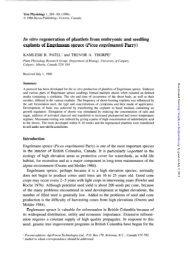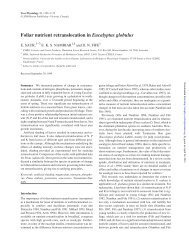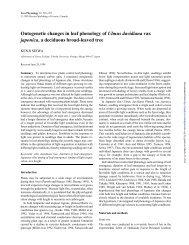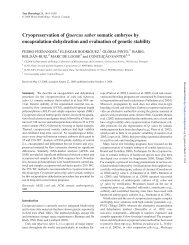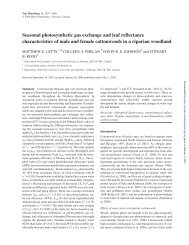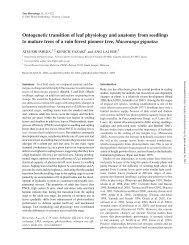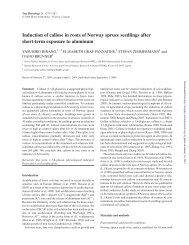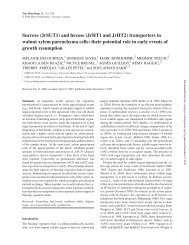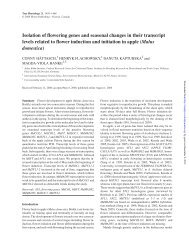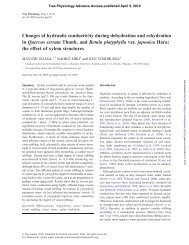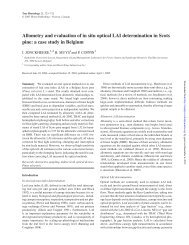Factors influencing axillary shoot proliferation and ... - Tree Physiology
Factors influencing axillary shoot proliferation and ... - Tree Physiology
Factors influencing axillary shoot proliferation and ... - Tree Physiology
You also want an ePaper? Increase the reach of your titles
YUMPU automatically turns print PDFs into web optimized ePapers that Google loves.
Table 1. Effects of temperature, explant type <strong>and</strong> cytokinins on <strong>shoot</strong><br />
<strong>proliferation</strong> from microcutting cultures of juvenile C. libani. Values<br />
are combined means from two experiments of 10 observations each.<br />
Cultures were established on MSBN/2 medium <strong>and</strong> culture time was<br />
60 days. Values followed by different letters are significantly different<br />
according to Tukey’s test at P < 0.05.<br />
Microcutting Temperature Shoots per explant<br />
(°C) Cytokinin (µM)<br />
cultured at 30 °C in either basal medium or Z-supplemented<br />
medium (Table 2).<br />
Based on these results, entire microcuttings of C. atlantica<br />
<strong>and</strong> C. libani were cultured at both 26 <strong>and</strong> 30 °C in the presence<br />
of Z or TDZ (Table 3). In both species, survival percentages<br />
were lower when microcuttings grown on cytokinin- supplemented<br />
medium were kept at 30 °C. This negative effect of<br />
the higher temperature was especially evident in C. atlantica<br />
microcuttings cultured in the presence of TDZ (40%). Sprouting<br />
percentages ranged from 80 to 100% <strong>and</strong> neither incubation<br />
temperature nor cytokinin type significantly influenced<br />
this response (P > 0.05, data not shown). In contrast, mean<br />
number of <strong>shoot</strong>s formed per explant was higher at 30 °C than<br />
at 26 °C (4.1 versus 2.9, P = 0.05), <strong>and</strong> Z was generally more<br />
effective than TDZ (4.1 versus 2.7, P = 0.05). Under the culture<br />
conditions tested, <strong>shoot</strong> <strong>proliferation</strong> rates were higher in<br />
C. libani than in C. atlantica microcuttings (4.7 versus 2.4, P =<br />
SHOOT PROLIFERATION IN CEDAR CULTURES 481<br />
0.0 2.2 BA 2.2 Z Mean 1<br />
Entire 26 4.4 2.3 5.3<br />
30 5.3 3.1 3.9<br />
Decapitated 26 3.6 1.3 4.6<br />
30 2.8 1.6 4.1<br />
Mean 2<br />
1 Effect of explant type.<br />
2 Effect of cytokinin type.<br />
4.0 a 2.1 b 4.5 a<br />
4.1 a<br />
3.0 b<br />
TREE PHYSIOLOGY ONLINE at http://heronpublishing.com<br />
0.05). The maximum number of <strong>shoot</strong>s formed per explant<br />
(7.0) was obtained when C. libani microcuttings were cultured<br />
on basal medium at 30 °C. This temperature effect was less evident<br />
in microcuttings isolated from <strong>shoot</strong>-proliferating cultures.<br />
In all experiments, <strong>and</strong> irrespective of the treatments, the<br />
sprouted buds reached a final length of 1 to 2 cm.<br />
These experiments were performed with seedlings from different<br />
seed stocks obtained from two commercial companies.<br />
To determine the variance attributable to the seed lots <strong>and</strong> to<br />
the individuals within each lot, the results were subjected to a<br />
nested ANOVA, which indicated that there was no significant<br />
effect of seed lot on survival or sprouting percentage. In contrast,<br />
variations in <strong>shoot</strong> yield were due to differences among<br />
seed lots (23 <strong>and</strong> 35% in C. atlantica <strong>and</strong> C. libani, respectively)<br />
<strong>and</strong> among seedlings within seed lots (77 <strong>and</strong> 65% for<br />
C. atlantica <strong>and</strong> C. libani, respectively).<br />
Axillary <strong>shoot</strong> <strong>proliferation</strong> from explants of mature origin<br />
None of the culture conditions tested promoted <strong>axillary</strong> <strong>shoot</strong><br />
<strong>proliferation</strong> from apical <strong>shoot</strong> meristems of mature trees of<br />
C. atlantica or C. libani. Most of the responding explants<br />
(60–70%) formed calli. Neither the culture medium (SH or<br />
MS/2) nor growth regulators (BA or NAA, or both) affected<br />
this morphogenic response. Meristem-derived calli were maintained<br />
in culture for almost 6 months, but attempts to induce<br />
organogenesis failed.<br />
Based on the data obtained with seedlings, <strong>shoot</strong> apices<br />
(0.6 cm) from 30-year-old C. libani were surface sterilized<br />
with either NaClO or HgCl2 <strong>and</strong> cultured on MSBN/2 medium<br />
with or without BA or NAA or both. Although the effectiveness<br />
of the two sterilizing agents was similar (an 80% yield of<br />
axenic explants), NaClO caused generalized chlorosis in some<br />
explants. Survival percentage was 50% <strong>and</strong> neither the sterilizing<br />
agent nor the presence of growth regulators significantly<br />
affected this result. Explant elongation <strong>and</strong> subsequent <strong>axillary</strong><br />
bud sprouting was observed only in cultures established<br />
on basal medium. Under these conditions, 15% of the explants<br />
elongated <strong>and</strong> showed bud sprouting (1–3 buds per explant)<br />
within 2–3 months of culture. Explants grown in the presence<br />
of BA with or without NAA formed calli.<br />
Table 2. Effects of temperature, explant type <strong>and</strong> cytokinins on <strong>shoot</strong> <strong>proliferation</strong> from microcutting cultures of juvenile C. atlantica. Values are<br />
combined means from two different experiments of 10 observations each. Cultures were established on MSBN/2 medium <strong>and</strong> culture time was<br />
60 days.<br />
Microcutting Cytokinin (µM) Survival (%) Sprouting (%) Shoots per explant Mean 1<br />
26 °C 30 °C 26 °C 30 °C 26 °C 30 °C<br />
Entire 0.0 100.0 100.0 92.3 91.7 1.9 3.8 2.9 a<br />
2.2 BA 100.0 83.3 66.7 75.0 1.1 1.6 1.4 b<br />
2.2 Z 91.7 83.3 91.7 91.7 2.5 4.4 3.5 a<br />
Mean 2<br />
83.6 a 86.2 a 1.8 b 3.3 a<br />
Decapitated 0.0 76.9 41.7 84.6 66.7 1.3 1.4 1.4 b<br />
2.2 BA 83.3 75.0 75.0 33.3 1.8 0.4 1.1 b<br />
2.2 Z 75.0 33.3 83.3 41.7 1.5 1.2 1.4 b<br />
Mean 2<br />
81.0 a 47.2 b 1.5 b 1.0 b<br />
1,2<br />
Interaction of explant type with cytokinins or temperature, respectively. For each interaction, values followed by different letters are significantly<br />
different according to Tukey’s test at P ≤ 0.05.<br />
Downloaded from<br />
http://treephys.oxfordjournals.org/ by guest on June 5, 2013



